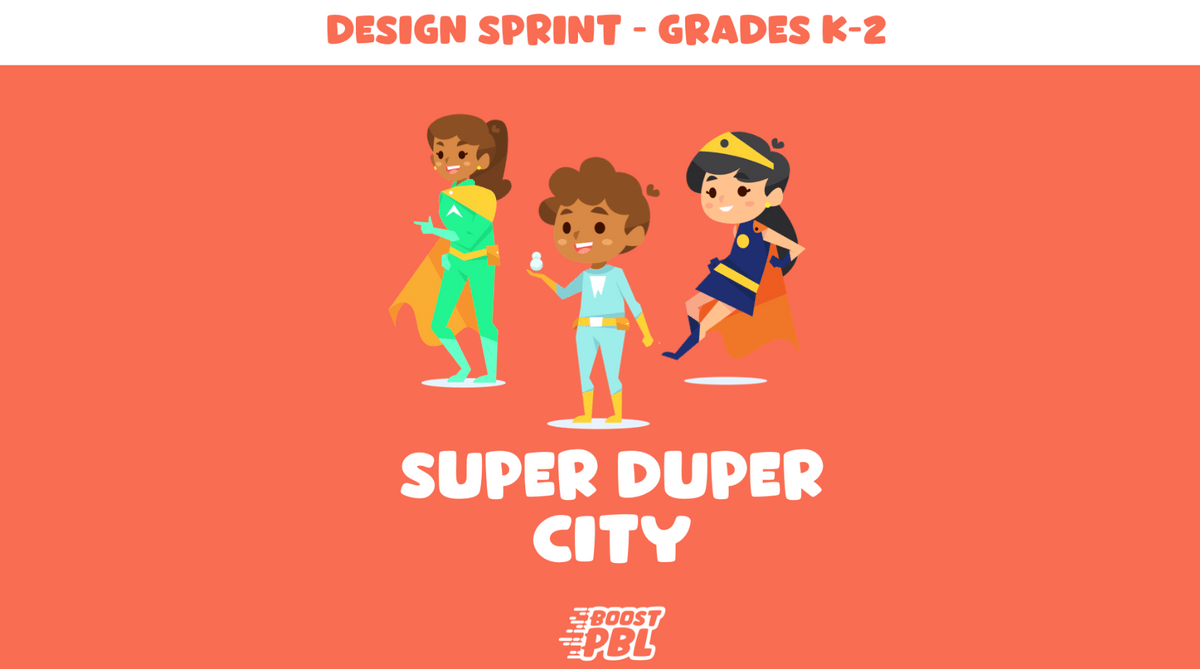
- Standards
- …
- Standards
- Standards
- …
- Standards
Super Duper City
k-2 Full Project, Mini-Project, and Sprint

PBL Experience Overview
1. Project Summary
- Grade Levels: Kindergarten, 1st, 2nd Grades
- Theme: City Planning and Engineering for Unique Needs
- Objective: Students design a city tailored to superpowered individuals, integrating solutions for challenges like safety, accessibility, and environmental impact.
- Duration: 3 weeks, 45 minutes per day
- Full Project: 3 weeks, 30-45 minutes per day
- Mini-Project: 5-7 days, 30-45 minutes per day
- Sprint: 2-3 days, 45-60 minutes per day
2. NGSS Standards Alignment
The project aligns with the following NGSS K-2 Engineering Design Standards:
- K-2-ETS1-1: Ask questions, make observations, and gather information to define a simple problem that can be solved through the development of a new or improved object or tool.
- Application: Students identify challenges superpowered individuals face in typical cities and propose solutions through city design.
- K-2-ETS1-2: Develop a simple sketch, drawing, or physical model to illustrate how the shape of an object helps it function as needed to solve a given problem.
- Application: Students create models of city features like buildings, roads, and safety systems for unique superpowers.
- K-2-ETS1-3: Analyze data from tests of two objects designed to solve the same problem to compare the strengths and weaknesses of how each performs.
- Application: Students test and evaluate city layouts for functionality, safety, and inclusivity.
3. Thematic Connections
- Science Concepts:
- Engineering and Problem-Solving: Students design buildings, roads, and transportation systems adapted to superpowers.
- Physics Concepts: Explore how forces (e.g., speed, strength) interact with structures in the city.
- Math Integration:
- Geometric concepts: Designing structures using 3D shapes (e.g., spheres, cones, cylinders).
- Data representation: Charting and graphing city layout ideas.
- Social Studies Integration:
- Exploring the role of urban planning in meeting diverse needs.
- Understanding the balance between safety, functionality, and aesthetics in city design.
- ELA Integration:
- Writing descriptions of city features and safety systems.
- Reading about famous cities and their unique features.
- Oral presentations to explain how their city accommodates different superpowers.
4. Benefits of Project-Based Learning
Kindergarten
- Early Urban Awareness: Introduces the concept of cities and their features in an engaging and imaginative way.
- Collaboration and Creativity: Encourages teamwork and creative thinking through playful design tasks.
- Problem-Solving Foundations: Builds early skills in identifying challenges and brainstorming solutions.
1st Grade
- Critical Thinking: Students think about real-world challenges (e.g., safety, accessibility) and apply their knowledge to design solutions.
- Cross-Disciplinary Learning: Combines geometry, science, and storytelling for a holistic learning experience.
- Empathy Development: Helps students consider the needs of others, such as those with special abilities or challenges.
2nd Grade
- Complex Urban Planning: Challenges students to consider advanced concepts like zoning, transportation systems, and resource allocation.
- Engineering Focus: Develops understanding of structural integrity and functionality in design.
- Leadership Skills: Builds confidence as students present and defend their city designs.
5. Additional Benefits
- Engagement: The superhero theme captivates students’ imaginations and motivates participation.
- Creativity and Innovation: Encourages students to think outside the box to solve unique problems.
- Skill Development: Enhances critical thinking, spatial reasoning, and communication skills.
6. Implementation Examples
- Day 1: Introduce the superhero challenge and discuss city elements (e.g., buildings, roads, safety features).
- Day 2: Identify superpowers and brainstorm city features that would accommodate them (e.g., tall buildings for flying heroes, water zones for aquatic heroes).
- Day 3: Sketch initial city layouts and discuss their ideas in small groups.
- Week 2: Build physical models of the city using materials like blocks, recycled items, and craft supplies.
- Week 3: Present their cities to peers, explaining how they meet the needs of superpowered individuals and solve common urban challenges.
7. Why This Project is Perfect for K-2
- Kindergarten: Introduces basic city elements in a fun, hands-on way, fostering imagination and teamwork.
- 1st Grade: Encourages practical problem-solving and integration of math and science concepts into creative design.
- 2nd Grade: Adds complexity with detailed urban planning and emphasizes engineering and leadership.
The "Super Duper City" project empowers students to think critically about design, inclusivity, and functionality while engaging in a highly imaginative and standards-based learning experience.
Home
Pricing Plans
Get Started
Contact Us
team@boostpbl.com
© BOOST PBL 2024

